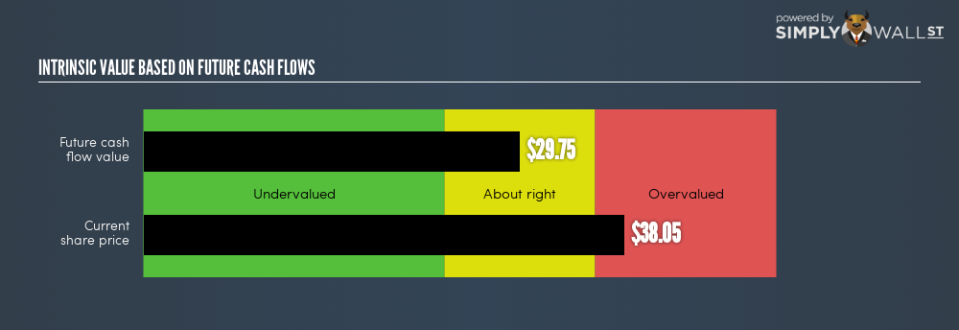MutualFirst Financial Inc (NASDAQ:MFSF) Investors Are Paying Above The Intrinsic Value

Bank stocks such as MFSF are hard to value. This is because the rules banks face are different to other companies, which can impact the way we forecast their cash flows. The tiered capital structure is common for banks to abide by, in order to ensure they maintain a sufficient level of cash for their customers. Looking at factors such as book values, in addition to the return and cost of equity, may be practical for assessing MFSF’s intrinsic value. Below we will look at how to value MFSF in a fairly effective and easy approach.
View our latest analysis for MutualFirst Financial
Why Excess Return Model?
Before we begin, remember that financial stocks differ in terms of regulation and balance sheet composition. United States’s financial regulatory environment is relatively strict. In addition to this, banks tend to not possess substantial amounts of tangible assets on their balance sheet. So the Excess Returns model is suitable for determining the intrinsic value of MFSF rather than the traditional discounted cash flow model, which places emphasis on factors such as depreciation and capex.
How Does It Work?
The main belief for Excess Returns is that equity value is how much the firm can earn, over and above its cost of equity, given the level of equity it has in the company at the moment. The returns above the cost of equity is known as excess returns:
Excess Return Per Share = (Stable Return On Equity – Cost Of Equity) (Book Value Of Equity Per Share)
= (11.21% – 9.82%) x $24.76 = $0.34
We use this value to calculate the terminal value of the company, which is how much we expect the company to continue to earn every year, forever. This is a common component of discounted cash flow models:
Terminal Value Per Share = Excess Return Per Share / (Cost of Equity – Expected Growth Rate)
= $0.34 / (9.82% – 2.95%) = $4.99
These factors are combined to calculate the true value of MFSF’s stock:
Value Per Share = Book Value of Equity Per Share + Terminal Value Per Share
= $24.76 + $4.99 = $29.75
This results in an intrinsic value of $29.75. Given MFSF’s current share price of US$38.05, MFSF is currently trading above what it’s actually worth. This means there’s no upside in buying MFSF at its current price. Pricing is only one aspect when you’re looking at whether to buy or sell MFSF. There are other important factors to keep in mind when assessing whether MFSF is the right investment in your portfolio.
Next Steps:
For banks, there are three key aspects you should look at:
Financial health: Does it have a healthy balance sheet? Take a look at our free bank analysis with six simple checks on things like bad loans and customer deposits.
Future earnings: What does the market think of MFSF going forward? Our analyst growth expectation chart helps visualize MFSF’s growth potential over the upcoming years.
Dividends: Most people buy financial stocks for their healthy and stable dividends. Check out whether MFSF is a dividend Rockstar with our historical and future dividend analysis.
For more details and sources, take a look at our full calculation on MFSF here.
To help readers see past the short term volatility of the financial market, we aim to bring you a long-term focused research analysis purely driven by fundamental data. Note that our analysis does not factor in the latest price-sensitive company announcements.
The author is an independent contributor and at the time of publication had no position in the stocks mentioned. For errors that warrant correction please contact the editor at editorial-team@simplywallst.com.

